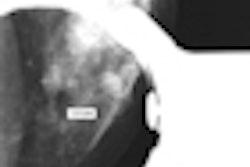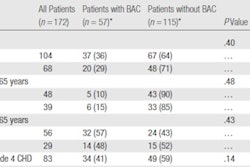SAN DIEGO - Women treated with breast conservation therapy (BCT) may do better with mammography follow-up twice a year rather than annual surveillance, according to research presented at this week's American Roentgen Ray Society (ARRS) meeting.
Among more than 8,000 BCT patients followed over a 10-year period, those who received mammography surveillance every six months had smaller, earlier-stage tumors when there was recurrence, compared with women who were followed annually, according to radiologists from the University of California, San Francisco (UCSF).
The findings could indicate that clinical protocols covering BCT surveillance that recommend annual follow-up might need to be re-examined, according to the authors.
BCT and recurrence
Breast conservation therapy is a widely used alternative to mastectomy for treating breast cancers discovered at an early stage. However, recurrence is common, with a cancer incidence rate of 1% to 2% per year, far higher than the incidence in the average asymptomatic screening population, at 0.1% to 0.4% per year. Therefore, continued surveillance is recommended for BCT patients.
In addition, studies show that the higher the stage at which recurrence is detected, the worse the prognosis. Conversely, the earlier the recurrence is detected, the better the prognosis, said Vignesh Arasu from UCSF.
To optimize outcomes, optimal surveillance is critical -- which means surveillance has been "studied to death," Arasu said. But not for everyone. "One question that remains is, what is the optimal interval for surveillance following BCT?" he said.
The American Cancer Society hasn't published recommendations on the subject, while other organizations recommend annual surveillance, he said.
Comparing two protocols
The UCSF researchers performed a retrospective review of the institution's mammography database to examine outcomes of two protocols followed at the institution between 1997 and 2008: Mammography every six months for women who undergo BCT -- or, alternatively, one mammogram a year for five years after treatment.
"At UCSF our policy is to invite them into semiannual screening for the first five years following BCT," he said. Those who decline may choose annual surveillance.
The criteria for joining one group or the other were fairly broad. Patients who received mammography surveillance at intervals of four to nine months were included in the semiannual group, while those who received follow-up at intervals of nine to 18 months were placed in the annual group.
For example, if a patient was assigned to semiannual screening but missed an appointment, she was assigned to the appropriate group if recurrence was detected, depending on screening frequency at the time of detection. Thus, the final group distinction was made at the end of the protocol, Arasu said.
The study end point was mammographically identified ipsilateral breast cancer recurrence, "which we defined broadly as either cancer recurrence or a second primary cancer, as mammography is not able to reliably distinguish" the two, Arasu said. All patients were asymptomatic and undergoing screening mammography.
From a total of 10,760 exams representing 2,329 patients, more than 2,000 exams had to be excluded, most often because no qualifying interval could be established between mammograms, Arasu explained. A total of 8,205 exams were analyzed in the study, at a mean of 4.6 exams per patient.
- Group I: 85% of the women underwent semiannual screening (mean age, 59.4 years; positive family history, 25%).
- Group II: 15% received annual screening (mean age, 60.3 years; positive family history, 27%).
In total, there were 155 biopsies (109 biopsy-proven cancer recurrences; positive biopsy rate, 72%), performed at a rate of 1.9% in group I and 2.1% in group II. All recurrences were stage IIA or earlier, Arasu said.
"The women who underwent semiannual screening had a significantly higher proportion of stage 0 and stage I cancer recurrences compared to women who chose annual mammograms," he said.
Recurrence stage in semiannual versus annual post-BCT surveillance groups
|
||||||||||||||||||||||||
| Data from Arasu, V; Joe, B; Lvoff, N; Leung, J; Brenner, R; Flowers, C; Chang, B; Sickles, E., UCSF, at ARRS 2010. |
"This is the first time a study has compared surveillance intervals in this select population, and the semiannual exam detected recurrence at a significantly earlier stage," Arasu said. "Moreover, the semiannual protocol did not increase the biopsy rate."
The results suggest that semiannual surveillance allows detection of recurrence at a significantly earlier stage, perhaps with smaller lesion sizes and more likely node-negative status, he said. As a result, semiannual screening may lead to better overall survival, inasmuch as the size of the lesion at detection is predictive of prognosis.
Limitations included the study's retrospective, single-institution design, and selection bias because patients were invited to pick their surveillance interval rather than be randomly assigned. But the two cohorts were similar in terms of age and family history, he said.
"One other limitation is that we were unable to measure the time to recurrence," Arasu said, which doesn't alter the results, but does limit the researchers' ability to examine the traits associated with recurrence. Many patients had their treatments at outside institutions, so time to recurrence was not available in all patients.
Finally, the follow-up period was not long enough to allow a comparison of survival between the two groups. Cancer organizations that publish guidelines may wish to consider doing so for this subgroup of breast cancer patients, Arasu said, adding that the promising results of this study will need to be validated in a randomized, controlled trial.
By Eric Barnes
AuntMinnie.com staff writer
May 5, 2010
Related Reading
Breast MRI improves cancer staging for newly diagnosed women, May 3, 2010
Investigational PET agent shows promise for breast cancer, April 30, 2010
Cryotherapy successfully freezes breast cancer, March 16, 2010
Radiation exposure increases risk of breast cancer, March 4, 2010
DCIS recurrence rates higher in younger women, October 7, 2009
Copyright © 2010 AuntMinnie.com



















